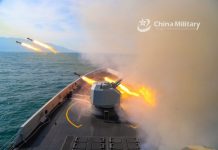At a time when India has been boasting the capabilities of French-origin Rafale fighter jets, now another French defence equipment – the Gazelle Helicopters have demonstrated its impressive capabilities to annihilate best of the MBTs (Main Battle Tanks).
Australian Drones Can Now Perform Policing Duties Including Forensic Crash Investigations: Watch Now
Under the helm of President Aleksandar Vučić, Serbian armed forces carried out the large live-fire Joint Action 2020 military exercises, which were dominated by the spectacular display of its French-made Gazelle attack helicopter, which shot down targets using the Soviet-era 9M14M Malyutka anti-tank missile.
A quartet of the helicopters were seen hovering in the air in formation in complete synergy with the anti-tank missiles, which were launched in spurts only to annihilate the ground targets directly on the plateau at the Pester training range.
Soon after the attack helicopters targeted a wooden house as part of the drill, which was diminished after being directly hit by a single missile, displaying the lethal match between the aerial attack vehicle and the launch weapon.
Considered to be one of the fastest helicopters on the face of the planet, Aérospatiale Gazelle SA 341 is a multi-role, lightweight utility/attack helicopter used in military applications such as an attack, anti-tank, anti-helicopter missions besides being used for transportation purposes.
Developed by France’s Aerospatiale Helicopter Corporation in the 1960s, the helicopter is used by Serbia along with approximately 22 other countries, with it serving several branches of the British Armed Forces including the Royal Air Force, Royal Navy, Army and Royal Marines.
British Army Gazelle helicopter flying over Belfast's City Hall in June 1977 pic.twitter.com/rMrd3vnPty
— ConflictNI (@ConflictNI) June 30, 2017
While commonly used for light transport, scouting and light attack duties, the five-seat Gazelle SA 341 has been considered a certified “tank buster”, having been used in combat operations in several countries.
“French Gazelles have fired missiles at Somali pirates and Iraqi tanks. Equipped in many cases with guided Mistral air-to-air missiles or Euromissile HOT anti-tank missiles with sighting systems and designators mounted on top of the cabin, the French have sold hundreds of these pocket-sized tank killers to countries lacking budgets for the high-tech, high-cost attack helicopters being developed today.” according to Bill Walton, a military expert and a life-long aviation enthusiast.
After entering service in 1973, the helicopters were manufactured in France and the United Kingdom by means of a joint production agreement with Westland aircraft, which was followed up by a manufacturing license obtained by Yugoslav aerospace manufacturer Soko, which led the possession of the helicopters by the Serbs.
According to Thomas Newdick, writing for The Drive – “Serbia’s remaining Gazelles are relics from the era of the still-unified Yugoslavia, in which these single-engine helicopters were built under license in Mostar, in what is now Bosnia-Herzegovina,”
Here, Yugoslavia’s SOKO aviation company, which is now defunct, undertook the manufacture of SA341H and improved SA342L Gazelles, in sub-variants that comprised utility, scout, and attack variants, the latter two known as the HERA and GAMA models, respectively.”
The SA 341 Gazelle is powered by a Turbomeca Astazou IIIA turboshaft engine, which is primarily used for civil and military applications, with the engine boasting the ability to generate about 440kW of output power.
With the ability to cruise at speeds of 264kilometres/hour, the Gazelle can fly at a maximum speed of 310 kilometres/hour and also has a climb rate of 12.2metre/second. The helicopter’s maximum take-off weight is 1,800kg and its range and service ceiling are 500 miles and 20,000ft respectively.
The weapons load of the helicopter consists of a GIAT M621 20mm cannon, four AT-3 ATGMs, two SA-7, 128mm or 57mm rockets and a 7.62mm machine gun in the cabin.
“Military Gazelles have been upgraded with the latest armament options, 3D navigational displays, electronic flight instrumentation system (EFIS) cockpit displays, night-vision goggle compatibility, ballistic armour packages, direct voice input (DVI) systems for voice control of aircraft systems, and advanced autopilot systems,” said Watson.




